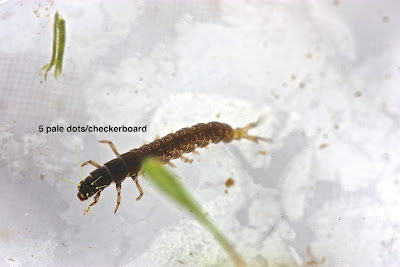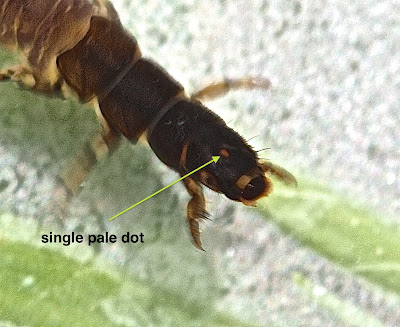I've been wanting to go to the Rapidan River ever since I discovered that it's not all that hard to identify common netspinners (Hydropsychidae) to the level of species -- well, some of them at least. I always see plenty of netspinners in this very fine river, initially wondering why they would inhabit this very clean water. Let's remember that in Virginia, common netspinners -- across the board -- are assigned a tolerance value of 6. So today, the Rapidan netspinners were the focus of my trip. Oh, I found lots of other nice insects as well, and I'll post those photos in a minute. But first -- what kind of netspinners do we find in this river?
I found at least three species of genus Ceratopsyche common netspinners: C. slossonae (the larva in the photo at the top of the page), C. morosa, and C. sparna. I now regret not picking up more larvae and taking more photos: I didn't expect such variety in one small part of the stream. (Remember, that Ceratopsyche is considered a sub-genus of Hydropsyche by some entomologists.)
I have featured Ceratopsyche sparna and Ceratopsyche morosa in previous entries (7/31 and 8/1). Both have very low tolerance values (2.5 and 2.3 respectively -- nothing like the 6.0 they would normally be assigned. Ceratopsyche sparna, you may recall, has 3 pale spots on the head (frontoclypeus): one in the center and two "anterolateral" (in front of and to the sides). C. sparna larvae look like this:
C. morosa netspinners have -- I'll quote from Beaty ("The Trichoptera of North Carolina," p. 73) -- a "head with 5-6 large pale spots in checkerboard pattern on frontoclypeus and usually ... three small white spots at posterior angle of frontoclypeus." My photos of C. morosa did not turn out very well, but you can make out the spots on the head. In the close-up, it appears as though there are indeed 6. (For a better photo of C. morosa, see the entry of 8/1).
Our third species -- Ceratopsyche slossonae -- is a new one, and although it's common, it's very intolerant with a tolerance value of 0.0.
Of all of the common netspinner species we've seen to this point, this one is the easiest for us to spot; you can pick it out with a loupe. C. slossonae larvae usually have a single yellow dot in the center of the head -- that's it. (There is a variation where there are three dots in a longitudinal row.) I think if you click on the photos enclosed, you can see this dot without a great deal of trouble. Here are some more photos for you to see.
And a close-up of the head:
(For detailed information on C. slossonae, see pp. 47-50 of "A Manual for the Identification of the Larvae of the Caddisfly Genera Hydropsyche Pictet and Symphitopsyche [now Ceratopsyche] Ulmer in Eastern and Central North Ameria," available on line.)
_________________
And what else did I see at the Rapidan River to photograph today?
1. I saw a lot of common stoneflies (Perlids), both Acroneuria and Paragnetina, the two genera I normally find in this stream. Below -- Paragnetina immarginata.
2. Fully mature Baetis intercalaris small minnow mayflies, both female and male.
3. A number of spiny crawler mayflies, genus Serratella. I should have kept the one in the photo below to check for species ID. I assume it was S. serratoides -- but I'd like to know that for sure.
4. And last but not least, a tiny Gomphid, a "Clubtailed" dragonfly nymph.


















No comments:
Post a Comment